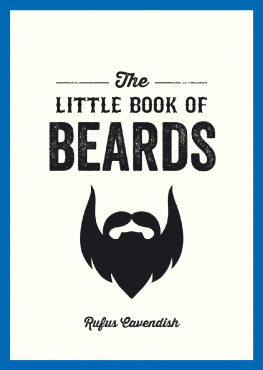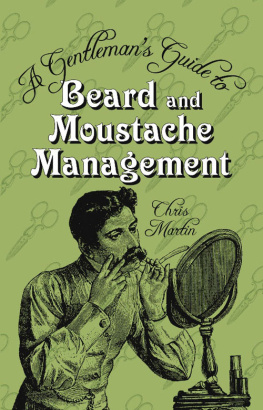THE ART OF GROWING A
BEARD
M ARVIN G ROSSWIRTH
F OREWORD BY
C OMMANDER E DWARD W HITEHEAD
I LLUSTRATIONS BY
A LBERT S IRINGO
D OVER P UBLICATIONS , I NC .
M INEOLA , N EW Y ORK
Copyright
Copyright 1971 by Marvin Grosswirth
All rights reserved.
Bibliographical Note
This Dover edition, first published in 2014, is an unabridged republication of the work originally published in 1971 by Jarrow Press, Inc., New York
Library of Congress Cataloging-in-Publication Data
Grosswirth, Marvin, 1931-1984.
The art of growing a beard / Marvin Grosswirth ; foreword by Commander Edward Whitehead ; illustrations by Albert Siringo.Dover edition.
p. cm.
eISBN-13: 978-0-486-79725-0
1. BeardsHumor. I. Title.
GT2320.G7 2014
391.5dc23
2014011933
Manufactured in the United States by Courier Corporation
78313801 2014
www.doverpublications.com
To Howard, who will find this book useful all too soon.
ACKNOWLEDGMENTS
Among those responsible for the realization of this book are:
Philip Deemer, who originated the idea; Arthur J. Goldsmith, Jr., who supported it; Mrs. Marianne S. Andersen, who is apparently making a career of editing male-oriented books; John Gangi, editor of Mens Hairstylist & Barbers Journal, and J. Nelson Snyder, Secretary of the Associated Master Barbers and Beauticians of America, both of whom contributed to the research; the incredible staff of the Mid-Manhattan Branch of the New York Public Library, for whom no question is too outlandish or obscure; and, most important, my wife, Marilyn: chief assistant researcher, copy editor, proofreader, idea tester, tantrum cooler, shock absorber, firm taskmaster, and gentle critic.
New York, June 1971
M.G.
TABLE OF CONTENTS
by Commander Edward Whitehead
THE ART OF GROWING A
BEARD
FOREWORD
From time to time, over the past 20 years, I have been invited to write a definitive book on beards. Largely because I have been preoccupied in other directions I have not accepted the challenge, and I have put it aside with the vague idea of tackling it in my dotage.
Meanwhile, I am glad to contribute this Foreword to Marvin Grosswirths scholarly work on the same subject.
I became acquainted with the author when he, in his role of chairman of New Yorks MENSA, invited me to address that organization on a subject of my own choosing. I took advantage of the occasion to test the validity of a thesis on which I was in the process of writing a book. The Human FactorHow To Succeed By Really Trying is a subject on which I have frequently spoken; now that I was expanding the text of the speech into a book, it was obviously valuable for me to bounce my ideas off the minds of a group of people in the top 2% of the national I.Q. range.
Though my forthcoming book has little to say on beards, there is some overlap of subject matter. For instance, I refer briefly to beards in a chapter on Style, or, to use an older word that I prefer, panache. I consider style, or panache, an important attribute of the successful man in any field. (I define success not as self-aggrandizement, or the acquisition of wealth and power, but as self-development and, ultimately, self-fulfillment.)
The original medieval meaning of the word panache was a tuft or plume of feathers worn in the helmet. It is not overstretching the point to translate that, in contemporary terms, as a tuft of hair worn on the chin. Thus, a beard is very much in line with present-day manifestations of style or panache. The author touches upon this point, and I should like to give it additional emphasis; especially as most men inclined to follow the advice offered in this book are probably also seeking to make a success of their lives.
This aspect of the subject is, to me, an indelible part of the case for growing a beard, and it has parallel bearing on the subject of conformity. In this day and age, when beards are still in the minority, nonconformity is a corollary of the case for beards.
I am an enthusiastic advocate of independence of mind, of individual initiative, of the wisdom of taking a line of ones own. Successful men in all walks of life tend to possess not only a strong character, but a high degree of individuality as well. Few are colorless conformists. Some are allowed mild idiosyncrasies, others are acknowledged eccentrics, a few are out-and-out cranks.
This is even truer in Britain, where we tolerate, if not encourage, the eccentric rather more freely. But in England the word crank means something a little different from the crotchety, irascible type usually so designated in this country. According to George Bernard Shaw, a crank was any man who had made up his mind on any subject whatsoever. But he was hypercritical.
Please dont imagine that I advocate eccentricity as an end in itself. Oddity for its own sake, with nothing to support it, has nothing to commend it. But I do advocate taking a line of ones own in one sphere, provided it is indicative of a similar capacity in other areas. I stress the need to act independently, to question the majority view, to maintain ones critical faculty, to make decisions based on ones own findings and to follow through.
This independence of mind can be manifested in many ways; growing a beard is just one of them. And it is important to remember that an attitude of mind is best expressed in action. Appearances, per se, do not mean much. I am against the growing of beards by every Tom, Dick and Harry.
Many years ago Mitch Miller told me, when a few of us, all bearded, were gathered together to discuss the subject on his radio program, that he had grown his beard when he had played the oboe in an orchestra. His friends had ridiculed his efforts to express himself in this way and he would have shaved it off, but for his wife, who said, You are a very good oboe player; you should keep it.
This provided me with a first-class illustration of my argument against indiscriminate beard growing. A man must have at least begun to assert himself, to prove his mettle, before he lays down the gauntlet quite so obtrusively.
Subject to this caveat, I can muster arguments for whiskers that I didnt dream existed when, in September, 1939 (a good year for beards), I heard that Britain had declared war. Spontaneously I threw my razor over the side, and vowed not to shave again until victory was ours. During the ensuing six years my beard served to keep the cold out in northern latitudes and the mosquitoes at bay in the South Pacific.
When, eventually, I left the Royal Navy, I retained my beard because Id become attached to itor it to me. My wife, who liked it, and my children, who grew up swinging on it, wouldnt hear of my shaving it off; and I, not caring much what other people thought, hung on to it.
During the postwar years in England beards were not especially common, but no one saw fit to question my right to retain mine. It was not, so to speak, a conversation piece. In fact, it was not until I arrived in New York in January, 1953, that my whiskers came into their own. During my first few weeks in New York I was mistaken, variously, for Thor Heyerdahl, the Deity, and others well known for hirsute adornment. But, once I had been persuaded to participate in my own advertising, there was no further occasion for mistaken identity.
Thereafter I found myself being interviewed and haranguing audiences on a wide variety of subjects. Invariably, however, the subject of beards would crop up and I would be closelybut always politelyquestioned on the subject.











